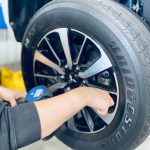Maintaining your vehicle inbetween services doesn’t require a visit to the mechanic. With some basic knowledge and a little effort, you can perform simple car care tasks at home to keep your vehicle running smoothly and prolong its lifespan. At Power Curve Automotive, we believe in empowering our customers with the knowledge they need to take care of their vehicles. Here are some easy DIY car care tips that you can handle yourself.






Regulary Check your oil
Oil is the lifeblood of your engine, and keeping it clean and at the right level is crucial for engine health. Here’s how you can check and change your oil:
- Park your car on level ground and turn off the engine. Wait a few minutes for the oil to settle if you only just moved your car. If you are returning from a drive, wait a few hours for the oil to cool and settle
- Open the hood and locate the oil dipstick. Pull it out and wipe it clean with a rag or paper towel.
- Reinsert the dipstick all the way in, then pull it out again to check the oil level. It should be between the “low” and “full” marks.
- Inspect the oil’s color and consistency. Fresh oil is amber, while dirty oil is darker and gritty. If it looks dirty, it’s time for a change.
Check Your Tire Pressure and Tread
Properly inflated tyres improve fuel efficiency, handling, and safety. Checking your tire pressure and tread regularly is a simple but important task.
Checking Tyre Pressure:
- Refer to your vehicle’s manual for the recommended tyre pressure.
- Use a tyre pressure gauge to check each tyre when they are cold.
- If the pressure is low, add air until it reaches the recommended level. If it’s too high, release some air.
Checking Tyre Tread:
- Use the 20-cent coin test: Insert a 20-cent coin into the tread with the platypus’s bill facing down. If you can see the bill, your tread is too low, and it’s time to replace the tires.
- Look for uneven wear patterns, which could indicate alignment issues or the need for rotation.
Replace Worn Wiper Blades
Clear visibility is crucial for safe driving, and functioning wiper blades are a key part of that. If your wiper blades are streaking or skipping, it’s time to replace them.
Replacing Wiper Blades:
- Lift the wiper arm away from the windshield.
- Press the small tab on the underside of the wiper where it meets the arm to release the old blade.
- Attach the new blade, making sure it clicks securely into place.
- Lower the arm back to the windshield gently to avoid damage.
Inspect Air Filters
Air filters prevent dirt and debris from entering your engine and cabin. Regularly inspecting and replacing them ensures optimal performance and air quality.
Engine Air Filter:
- Locate the air filter housing, usually a black box near the engine.
- Open the housing and remove the old filter.
- Inspect the filter for dirt and debris. If it’s dirty, replace it with a new one.
- Close the housing securely.
Cabin Air Filter:
- Locate the cabin air filter, usually behind the glove box or under the dashboard.
- Remove the old filter and inspect it for dirt and debris.
- Replace it with a new filter if necessary.
Maintain Your Battery
A well-maintained battery ensures your vehicle starts reliably. Regularly checking and cleaning the battery can prevent unexpected breakdowns.
Checking and Cleaning Your Battery:
- Check the battery terminals for corrosion (white, ashy deposits).
- If you see corrosion, disconnect the battery (negative terminal first) and clean the terminals with a mixture of baking soda and water using a brush.
- Rinse with water and dry thoroughly before reconnecting the battery (positive terminal first).
- Ensure the battery is securely mounted and check the charge with a voltmeter if you have one. A fully charged battery should read around 12.6 volts.
Inspect Belts and Hoses
Belts and hoses play critical roles in your vehicle’s operation. Regular inspection can prevent breakdowns and costly repairs.
Inspecting Belts:
- Look for cracks, fraying, or glazing on the belts.
- Check the tension by pressing down on the belt. It should have a bit of give but not be too loose.
Inspecting Hoses:
- Look for leaks, cracks, or bulges.
- Check the clamps and connections to ensure they are secure.
- Squeeze the hoses gently to check for firmness. A hose that feels soft or spongy may need to be replaced.
Keep Your Car Clean
Regular cleaning not only keeps your car looking good but also protects the paint and interior from damage.
Cleaning Tips:
- Wash your car regularly to remove dirt, grime, and salt.
- Wax your car every few months to protect the paint and give it a shiny finish.
- Clean the interior by vacuuming the seats and carpets, wiping down surfaces, and using a protectant on the dashboard and other plastic parts.
